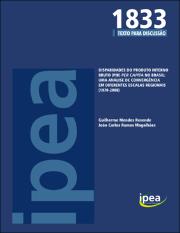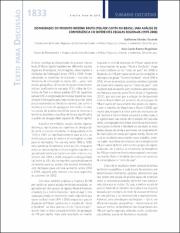Please use this identifier to cite or link to this item:
https://repositorio.ipea.gov.br/handle/11058/1212Full metadata record
| DC Field | Value | Language |
|---|---|---|
| dc.contributor.author | Resende, Guilherme Mendes | - |
| dc.contributor.author | Magalhães, João Carlos Ramos | - |
| dc.coverage.spatial | Brasil | pt_BR |
| dc.coverage.temporal | 1970-2008 | pt_BR |
| dc.date.accessioned | 2013-06-17T12:18:57Z | - |
| dc.date.available | 2013-06-17T12:18:57Z | - |
| dc.date.issued | 2013-05 | - |
| dc.identifier.uri | http://repositorio.ipea.gov.br/handle/11058/1212 | - |
| dc.description.abstract | Este texto investiga a evolução das disparidades do produto interno bruto (PIB) per capita brasileiro – cunhada na literatura de convergência sigma (σ) –, entre 1970 e 2008, em quatro escalas regionais (municípios, microrregiões, mesorregiões e Unidades da Federação), utilizando quatro diferentes estatísticas: coeficiente de variação, desvio-padrão, índice de Theil e índice de Gini. Os resultados revelam que, quanto menor a escala de análise, menor é a queda da desigualdade entre 1970 e 2008. A mesma análise feita para dois subconjuntos (ou clubes) de regiões mostra que a significativa queda da desigualdade ocorrida entre os estados do Norte e Nordeste desaparece quando a escala de análise é menor e, segundo alguns indicadores, chega a aumentar entre as microrregiões e municípios. No entanto, os resultados para o resto do país não são tão afetados pela mudança de escala. Assim, pode-se sugerir a ocorrência de processos distintos de convergência do PIB per capita entre os dois grupos de regiões analisados. Isto é, verifica-se um processo de divergência dos PIBs per capita em âmbito microrregional e municipal nas regiões Norte e Nordeste e um processo de convergência no “resto do país”. Este resultado mostrou que não existe uma escala de análise capaz de sintetizar toda a dinâmica regional e que seja mais precisa que as outras, sendo que uma abordagem multiescalar revela-se útil para um melhor entendimento das disparidades dos PIBs per capita regionais no Brasil. | pt_BR |
| dc.language.iso | pt-BR | pt_BR |
| dc.publisher | Instituto de Pesquisa Econômica Aplicada (Ipea) | pt_BR |
| dc.title | Disparidades do produto interno bruto (PIB) per capita no Brasil: uma análise de convergência em diferentes escalas regionais (1970-2008) | pt_BR |
| dc.title.alternative | Texto para Discussão (TD) 1833: Disparidades do produto interno bruto (PIB) per capita no Brasil: uma análise de convergência em diferentes escalas regionais (1970-2008) | pt_BR |
| dc.title.alternative | Disparities of the gross domestic product (GDP) per capita in Brazil: an analysis of convergence in different regional scales (1970 to 2008) | pt_BR |
| dc.type | Texto para Discussão (TD) | pt_BR |
| dc.rights.holder | Instituto de Pesquisa Econômica Aplicada (Ipea) | pt_BR |
| dc.source.urlsource | www.ipea.gov.br | pt_BR |
| dc.location.country | BR | pt_BR |
| dc.description.physical | 47 p. : il. | pt_BR |
| dc.rights.license | É permitida a reprodução deste texto e dos dados nele contidos, desde que citada a fonte. Reproduções para fins comerciais são proibidas. | pt_BR |
| dc.subject.keyword | Produto Interno Bruto (PIB) | pt_BR |
| dc.subject.keyword | Disparidade regional de renda | pt_BR |
| dc.subject.keyword | Literatura de convergência sigma | pt_BR |
| dc.subject.keyword | Dinâmica regional | pt_BR |
| ipea.description.objective | Investigar as disparidades do produto interno bruto (PIB) per capita brasileiro em diferentes escalas regionais (municípios, microrregiões, mesorregiões e Unidades da Federação) entre 1970 e 2008. | pt_BR |
| ipea.description.additionalinformation | Série monográfica: Texto para Discussão ; 1833 | pt_BR |
| ipea.description.additionalinformation | Referências bibliográficas: possui referências bibliográficas | pt_BR |
| ipea.description.additionalinformation | Conteúdo: possui apêndice | pt_BR |
| ipea.description.additionalinformation | Anexo: sumário executivo | pt_BR |
| ipea.access.type | Acesso Aberto | pt_BR |
| ipea.rights.type | Licença Comum | pt_BR |
| ipea.englishdescription.abstract | This paper investigates the evolution of the Brazilian per capita Gross Domestic Product (GDP) – known as sigma (σ)-convergence –, between 1970 and 2008 across four geographic scales (municipalities, micro-regions, meso-regions and states), using four different statistics – coefficient of variation, standard deviation, Theil index and Gini index. The results reveal that the smaller the scale of analysis the smaller the decrease in inequality between 1970 and 2008. The same analysis conducted for two groups (or clubs) shows that the significant reduction in inequality which happened among the states from the North and Northeast disappears as the scale of analysis gets smaller and, according to two of the four statistics, it even increases between the micro-regions and municipalities. As for the rest of the country the results are not strongly affected by the scale reduction. This suggests the occurrence of a distinct convergence process of the per capita GPD between the two groups of regions, characterized by the divergence of the per capita GDP among the micro-regions and municipalities from the North and Northeast and the convergence for the “rest of the country”. This result shows that there is not one scale that is able to synthesize all the regional dynamics and that is more accurate than the others. In this sense, a multi-scale approach may be useful for a better understanding of the regional per capita GDP disparities in Brazil. | pt_BR |
| ipea.researchfields | Macroeconomia para o Desenvolvimento | pt_BR |
| ipea.classification | Economia. Desenvolvimento Econômico | pt_BR |
| Appears in Collections: | Economia. Desenvolvimento Econômico: Livros | |
Files in This Item:
| File | Description | Size | Format | |
|---|---|---|---|---|
| TD_1833.pdf | Arquivo principal | 2.63 MB | Adobe PDF |  View/Open |
| TD_1833_sumario executivo.pdf | Sumário executivo | 55.61 kB | Adobe PDF |  View/Open |
Items in DSpace are protected by copyright, with all rights reserved, unless otherwise indicated.

